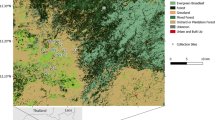Play all audios:

ABSTRACT COLLECTIONS of mosquitoes have been made regularly throughout the dry season in the desert west of Omdurman, Sudan, by means of pyrethrum-spraying, well-traps and hand catching. The
results indicate that adult female _Anopheles gambiae_ (sp. B ?) Giles survive throughout the dry season, but with a change in their physiology and behaviour. The insects were found to hide
in dwelling huts (87.7 per cent), in cracks down dry wells (8.5 per cent), in disused or ruined houses (3.2 per cent) and in rabbit and rodent burrows (0.5 per cent). Dissection showed that
77.1 per cent of the nulliparous females captured were engorged with blood. Of these, 90.6 per cent contained human blood. The ovaries evidently undergo only one gonotrophic cycle during
the dry season, developing extremely slowly so that, when the rains come, the gravid females are ready to oviposit. These mosquitoes are apparently unable to lay eggs during the dry season.
Access through your institution Buy or subscribe This is a preview of subscription content, access via your institution ACCESS OPTIONS Access through your institution Subscribe to this
journal Receive 51 print issues and online access $199.00 per year only $3.90 per issue Learn more Buy this article * Purchase on SpringerLink * Instant access to full article PDF Buy now
Prices may be subject to local taxes which are calculated during checkout ADDITIONAL ACCESS OPTIONS: * Log in * Learn about institutional subscriptions * Read our FAQs * Contact customer
support SIMILAR CONTENT BEING VIEWED BY OTHERS ANOPHELES ECOLOGY, GENETICS AND MALARIA TRANSMISSION IN NORTHERN CAMBODIA Article Open access 19 March 2021 VECTORIAL DRIVERS OF MALARIA
TRANSMISSION IN JABI TEHNAN DISTRICT, AMHARA REGIONAL STATE, ETHIOPIA Article Open access 13 June 2024 AMAZONIAN _ANOPHELES_ WITH LOW NUMBERS OF OOCYSTS TRANSMIT _PLASMODIUM VIVAX_
SPOROZOITES DURING A BLOOD MEAL Article Open access 14 November 2022 AUTHOR INFORMATION AUTHORS AND AFFILIATIONS * Department of Zoology, University of Khartoum, SALAH M. OMER & J. L.
CLOUDSLEY-THOMPSON Authors * SALAH M. OMER View author publications You can also search for this author inPubMed Google Scholar * J. L. CLOUDSLEY-THOMPSON View author publications You can
also search for this author inPubMed Google Scholar RIGHTS AND PERMISSIONS Reprints and permissions ABOUT THIS ARTICLE CITE THIS ARTICLE OMER, S., CLOUDSLEY-THOMPSON, J. Dry Season Biology
of _Anopheles gambiae_ Giles in the Sudan. _Nature_ 217, 879–880 (1968). https://doi.org/10.1038/217879b0 Download citation * Received: 06 February 1968 * Issue Date: 02 March 1968 * DOI:
https://doi.org/10.1038/217879b0 SHARE THIS ARTICLE Anyone you share the following link with will be able to read this content: Get shareable link Sorry, a shareable link is not currently
available for this article. Copy to clipboard Provided by the Springer Nature SharedIt content-sharing initiative
